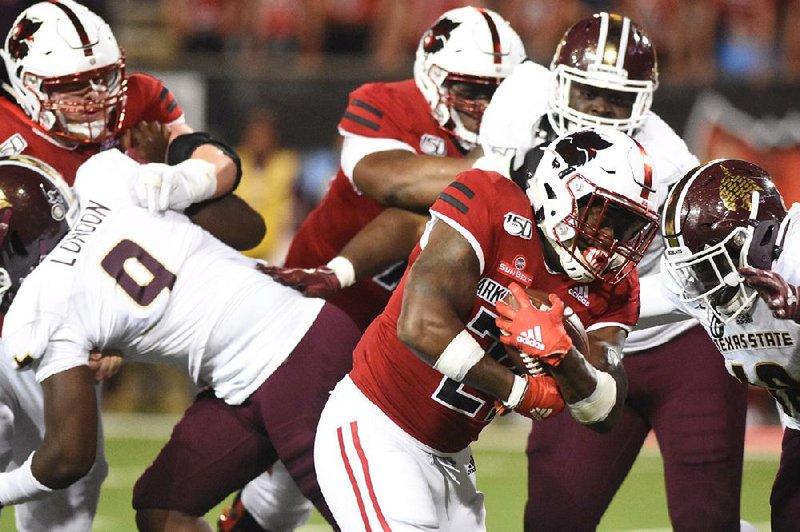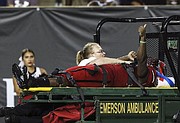JONESBORO -- Jamal Jones entered this season with little shot of seeing the field. His place on the depth chart reflected that.
By the end of Arkansas State University's preseason camp in August, the fifth-year senior was fifth in the running back rotation behind two underclassmen and two transfers. A concussion earlier in camp had cast him aside, as he watched sophomore Marcel Murray, ASU's leading rusher in 2018; junior-college transfers Ryan Graham and DJ Chatman; and true freshman Isaiah Azubuike pass him over.
Jones was left searching for answers. He was behind four players, none of whom had been at ASU nearly as long as him. Jones, who had appeared in 12 games over his career and missed nearly all of the prior season with an injury, didn't know when his chance would come, if it would come at all.
He had redshirted as a true freshman in 2015, then saw limited action over the next two years before getting hurt at the start of the 2018 season. Prior to this year, Jones had carried the ball 50 times for 208 yards in his career, but he had yet to find the end zone.
One day late in August, with camp winding down and the season opener against SMU approaching, Jones was inside ASU's new north end-zone facility when he caught offensive coordinator Keith Heckendorf walking up the stairs and told him he wanted to talk.
"I remember exactly where we were, exactly when it happened," Heckendorf said. "He was at a place where he was really questioning his role on this team and where he fit.
"I said, 'Where you're at today isn't necessarily where you want to be, but that can change really fast throughout the course of a season. The key to the whole thing's gonna be how you react to this ... how you respond and what your attitude is going forward, because at some point in this season, this team's gonna need you.' "
At a glance
Jamal Jones
POSITION Running back
CLASS Redshirt senior
HEIGHT 5-9
WEIGHT 193
HOMETOWN Memphis
NOTEWORTHY After entering this season with 50 carries, 208 yards and no touchdowns in his Arkansas State career, Jones has 48 attempts for 181 yards and 3 touchdowns this year in a reserve role.
Those weren't empty words. But in the meantime, the 5-9, 193-pound running back looked inward.
He knew he had to become more disciplined and spend the time necessary to learn the offense.
"It's easy to be [fifth] string and not care. It's easy to be like, all right, whatever, I'm not going to play anyways," Jones said. "But if you have that mindset ... and it's your turn to play, it's going to show that you're not prepared, that you're not ready.
"I was so focused on what Coach Heck told me. I used that as fuel, and I used that to keep everything positive, because I could be an asset to the team."
When ASU shifted its preparation for the season opener against SMU, Jones was still an afterthought.
"We started the game plan, I was nowhere in it," Jones said.
'This my way out'
Improving his status on the depth chart hardly has been the brunt of the battle of Jones' life. It goes much deeper than the football field.
Jones, a native of Memphis, grew up without his parents at home, which began around the time he got to middle school. His older sister, Erika, was the one who helped raised him and his older brother, Kordaryus.
They lived in the Frayser community of north Memphis, where poverty and crime are rampant, in Section 8 housing.
"It was a bad area, man," Jones said. "A bad area."
Meals were tough to come by. Jones remembers having to scrape for change so he could get something to eat.
When Erika had a child at the age of 14, it placed even greater responsibility on her and her siblings.
"My sister looking out for us, she's having a baby and she's having to go to school, try to finish and graduate and all these things. Sometimes I had to miss school to watch my nephew," Jones said. "It was just us in the house. We had each other."
Jones eventually grew into a star on the football team at Trezevant High School.
Jones' high school Coach Teli White remembers Jones coming to him as a seventh-grader at the school's gym and begging him to lift weights, a rarity for most middle-school athletes.
"Coach, this my way out," Jones told him. "This my way out."
It's a moment that has stuck with White for years. White was always taken aback by Jones' drive, character and work ethic, and he could never tell Jones' situation at home was a burden.
"That kid will always work, and if you got on him about not working hard enough, he'll go back in there and try to do it again," White said. "You would think that he was going home to a two-parent household every night, but he wasn't."
The work started to pay off during his sophomore season at Trezevant, when Jones rushed for over 1,000 yards, a mark he surpassed again as a junior and senior.
He became a three-star prospect, one of the top running back recruits in Tennessee and held multiple Division 1 offers. He committed to Arkansas State in July 2014 and inked with the program the following February on national signing day.
Jones and White have remained close since the running back moved to Jonesboro, which is an hour away from Memphis. White speaks of Jones in a manner unlike that of any player he's ever coached, going as far to say that if he had a daughter, it'd be a no-brainer to let Jones marry her.
"That kid is special," White said. "I wasn't even worried about when he was at the bottom of the depth chart [this season]. He came from the bottom, and I mean that literally."
Almost quitting
The hit that almost caused Jones to quit football happened during last year's season opener against Southeast Missouri State. Jones ran to the left before he was walloped by three defenders and "bent at this weird angle."
He lay on the turf at Centennial Bank Stadium motionless, the crowd in silence. Minutes later, he was being carted off the field, not knowing if this was the end of his career.
Jones suffered a spinal injury -- he had a bulging disc in his L4, L5 and S1 -- and a concussion. For two days, he was bound to a hospital bed and unable to walk. Playing football again was out of the picture.
"At that point, I was done with football," Jones said. "In my mind, it wasn't worth it. It wasn't worth coming back to play."
For weeks after the injury, Jones struggled. He couldn't go to class; he couldn't put his pants or socks on or touch his toes; he couldn't do much of anything except lay around.
Daily life was painful, and Jones endured a grueling rehab. He gradually improved over the rest of the season, and by the time bowl practices started, he had been cleared to participate. But he was still a shot fighter mentally, and he remained unsure whether he should play again.
"I was still showing up to stuff, but it was like I wasn't really present," Jones said. "I'm usually like the life of the place. I'm smiling, people just like being around me, and I just became this dull person who just looked like they didn't want to be here."
Around the start of spring camp, Jones and ASU Coach Blake Anderson met in his office, and Anderson asked him whether he planned on coming back for the 2019 season.
Jones said, halfheartedly, that he was. Deep down, there was more eating at him.
"I was lying to him and I was lying to myself, and he could see it," Jones said. "He said, 'I want you to go back to your room and I want you re-evaluate who you are as a person.' He was like, 'How do you want other people to view you?' So I had to be honest with myself.
"I made it to this point, I've been through worse than an injury and I have family. I got a nephew that's looking up to me. If I quit right now, then what type of example am I setting?"
Jones followed Anderson's directive. He went home, he looked in the mirror and he thought about what Anderson had told him. He couldn't stand the person he saw.
Jones realized that he couldn't walk away.
"Obviously you come into college and you've got visions of what you want your career to look like, and for whatever reason, his just wasn't fitting that pattern," Anderson said. "There's a reality check at some point, like this is where I'm at, this is my role and it's not what I anticipated it being, but it can still be helpful to the team."
A few days later, Jones called Anderson and informed him of his decision.
"Coach," Jones said, "I'm all in."
Getting his turn
As the weeks passed after his conversation with Heckendorf in August, Jones continued to wait.
The Red Wolves' running back depth began taking hits in Week 2.
Murray rolled an ankle in the first half of ASU's 43-17 victory at UNLV on Sept. 7, an injury that would plague him over the next several weeks. Graham tore an ACL during a 41-28 home victory over Southern Illinois on Sept. 21, and Azubuike suffered a season-ending ankle injury in a 52-38 loss at Georgia State on Oct. 5.
Jones received his first carries of the season Sept. 14 at then-No. 3 Georgia -- a 55-0 rout for the Bulldogs -- rushing three times for 8 yards in garbage time.
But on Sept. 28, in the Sun Belt Conference opener at Troy, Jones' time arrived.
Graham and Murray were out, and Azubuike got banged up during the game with a hip pointer. Chatman was relegated to the bench after two costly fumbles in the first half.
For Jones, opportunity finally knocked.
"Throughout the [game], I was numb, but I was prepared," Jones said. "I was prepared the whole time."
He finished with 14 carries for 54 yards, including a 7-yard rushing touchdown -- the first score of his career -- midway through the third quarter that gave the Red Wolves a 38-34 lead, one they wouldn't relinquish in a 50-43 victory.
After the game, Jones cried in the locker room. The patience had paid off.
"It just hit me, man," Jones said. "I prayed a lot for the opportunity, and I got it. My heart was just filled at the moment."
Even as Murray's health improved and he saw a return to a normal workload in the coming weeks, Jones' performance against Troy that night didn't become a flash in the pan.
On Oct. 26, in a 38-14 victory over Texas State in Jonesboro, Jones registered 13 carries, a new career high in rushing yards with 63 and a touchdown. The next week, during a 48-41 victory at Louisiana-Monroe, he scored another touchdown -- this one an 8-yard dagger midway through the fourth quarter that gave ASU a 14-point lead.
Jones, who graduated from ASU in August and is working on his masters, plans on returning to the Red Wolves for one final season next year, which will mark his sixth with the program.
Murray, Graham, Azubuike and Chatman are expected back, too, and Jones will once again be in a tight competition for playing time.
It's a position Jones has grown accustomed to -- unsure of when his next opportunity arises, but sure of why he's there in the first place.
"It's all worth it," Jones said. "If you just keep fighting, it's all worth it."
Sports on 11/22/2019

